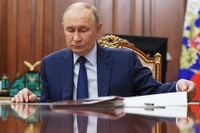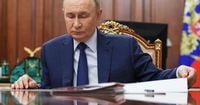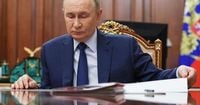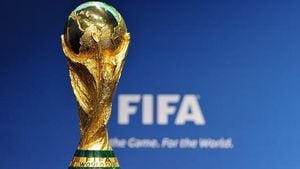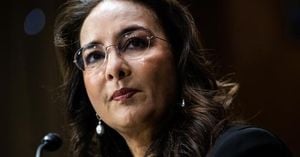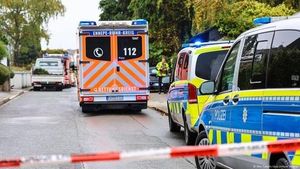The last remaining nuclear arms agreement between the United States and Russia—known as the New START treaty—has found itself thrust back into the international spotlight, as both leaders tentatively signal willingness to keep its critical limits in place for at least another year. On October 6, 2025, the Kremlin publicly welcomed U.S. President Donald Trump’s recent comments supporting Russia’s offer to extend the treaty, which is set to expire in February 2026. The move injects a glimmer of hope into an otherwise fraught period of U.S.-Russia relations, marked by the ongoing war in Ukraine and the unraveling of decades-old arms control frameworks.
Russian President Vladimir Putin set the stage last month by declaring his readiness to maintain the 2010 New START treaty’s restrictions for one more year, urging Washington to reciprocate. When asked about the proposal on Sunday, October 5, President Trump responded, “sounds like a good idea to me.” The Kremlin, quick to seize on this rare point of accord, expressed optimism that the U.S. would support Putin’s initiative. Kremlin spokesman Dmitry Peskov told reporters the next day that Trump’s statement “provides grounds for optimism that the United States supports President Putin’s initiative,” according to The Associated Press and The New York Times.
The New START treaty, signed in 2010 by then-U.S. President Barack Obama and Russian President Dmitry Medvedev, places strict caps on the two nations’ deployed long-range nuclear arsenals: no more than 1,550 deployed nuclear warheads and 700 deployed missiles and bombers for each side. It also requires annual on-site inspections and data-sharing to verify compliance—although these provisions have been on ice since 2020, when the COVID-19 pandemic led to a suspension of inspections that has never been reversed.
While the treaty was originally set to expire in 2021, President Joseph R. Biden Jr. extended it for five years shortly after taking office, using the pact’s single allowed extension. Now, with the February 2026 deadline looming and no successor agreement in sight, the future of nuclear arms control hangs in the balance. As The New York Times notes, any further formal extension would require a new treaty, subject to complex negotiations and approval by two-thirds of the U.S. Senate—a tall order in today’s polarized political climate.
Putin has been clear about the stakes. He warned that allowing the treaty to lapse would be “destabilizing and could fuel proliferation of nuclear weapons,” as reported by The Associated Press. He also suggested the proposed one-year extension could serve as a window for negotiating a broader, more inclusive arms control pact—one that might address not just long-range strategic weapons, but also battlefield nuclear arms and the next generation of strategic weapons systems that Russia has developed in recent years. “We haven’t forgotten about anything that we have planned, the work is ongoing and it will produce results,” Putin declared at a recent international forum.
There’s no shortage of hurdles. For one, Putin has floated the idea—long championed by Washington—of bringing China into future arms control talks. However, Beijing has consistently rebuffed this, arguing that its nuclear arsenal is far smaller than those of the U.S. or Russia. Putin has also raised the prospect of including the nuclear forces of NATO allies Britain and France in any new deal, a suggestion that would further complicate already delicate negotiations.
Meanwhile, the practical machinery of New START is showing its age. The treaty’s mechanisms for mutual inspections and data exchanges have been largely dormant since the pandemic. In 2023, Putin formally suspended Russia’s participation in most aspects of the treaty, except for the numerical limits on deployed weapons. After Russia stopped providing data, the United States followed suit. As of now, it remains unclear whether Moscow would be willing to revive the full suite of verification measures, even if the treaty’s limits are extended for another year.
The geopolitical context is as tense as ever. Russia’s ongoing war in Ukraine, coupled with biting international sanctions, has put enormous economic pressure on the Kremlin. In fact, Moscow plans to spend less on its military in 2026 than in 2025, though security and defense will still consume a hefty 38 percent of its federal budget, according to The New York Times. Extending New START’s caps could help Russia avoid the financial and strategic risks of a renewed nuclear arms race—at a time when its resources are stretched thin by the conflict in Ukraine.
For the United States, the calculus is equally complex. While Trump has expressed openness to the extension, he has so far refrained from making any major deals with Moscow while Putin continues his campaign in Ukraine. Still, maintaining the treaty’s limits could provide a crucial back channel for U.S.-Russia dialogue on issues unrelated to the war—a diplomatic track that Moscow has been seeking, but which Washington has approached with caution.
The broader arms control landscape is grim. Over the years, a series of treaties designed to limit nuclear arsenals and reduce the risk of conflict have eroded amid worsening relations between Moscow and Washington. With New START on the brink, arms control advocates warn of a dangerous vacuum. As The Associated Press points out, the expiration of the treaty could trigger a new nuclear arms race and sharply increase the risk of a catastrophic miscalculation.
Putin, for his part, has adopted a pragmatic—if somewhat defiant—tone. He acknowledged that some in the United States oppose extending New START, adding, “if they don’t need it, we don’t need it either. We feel confident about our nuclear shield.” Yet his willingness to keep the treaty’s limits in place, at least temporarily, suggests that even the Kremlin recognizes the perils of unchecked nuclear competition.
As the February 2026 deadline approaches, the fate of New START remains uncertain. The coming months will test whether the tentative signals from both Washington and Moscow can translate into concrete action—or whether the world’s two largest nuclear powers are headed for a new era of rivalry without guardrails. For now, the world watches and waits, hoping that common sense and diplomacy can prevail over mistrust and brinkmanship.
With the stakes as high as ever, the next steps taken by the U.S. and Russia will shape the global nuclear order for years to come.
